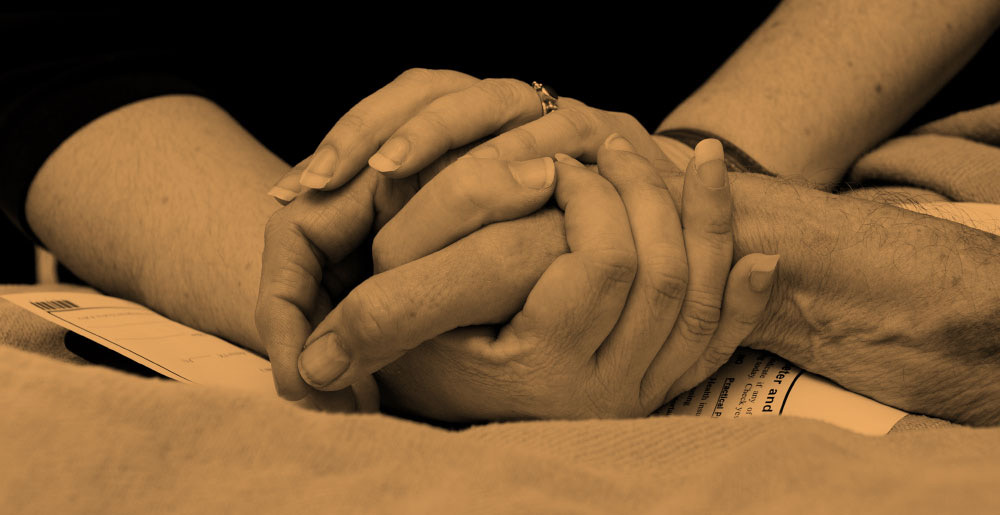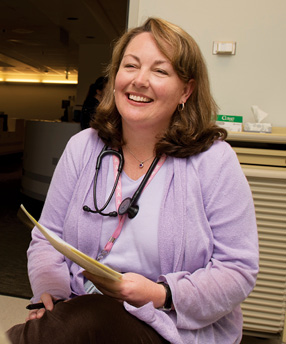
The sixth vital sign
Distress screening critical to patient care
When a patient is diagnosed with cancer, one crucial question typically leaps to mind: Am I going to survive this? Before long, however, comes a torrent of other worries, from the adequacy of health insurance to questions about caregivers, economic solvency and impacts on family, as well as physical ability, pain and quality of life. Such challenges can create anxiety and depression, undermining patients’ ability to focus on their return to health.
In decades past, the oncology community occasionally overlooked these psychosocial issues — sometimes defined as the “soft side of cancer.” However, the focus on patient-centered care has brought to light the need to understand and offer patients and their families support in coping and adjusting to cancer. In response, the UC Davis Comprehensive Cancer Center is gearing up to formally screen all patients for distress as part of their care, essentially making it the sixth vital sign.
Oncologists say implementing distress screening is critical to enhance the effectiveness of cancer treatment and reduce health care costs. It also reflects the cancer center’s holistic view of patient care and support.
“At UC Davis, our goal is to not just treat the disease, but to care for the entire patient, from the time of diagnosis all the way through survivorship,” says medical oncologist and associate professor of medicine Kendra Hutchinson. “We need to look at the bigger picture and go beyond our patients’ acute cancer issues to consider their psychological, emotional and even spiritual health.”
Pilot screening yields stunning findings
Formal distress screening for all patients will begin at the cancer center in early 2015. As a prelude, the cancer center’s two social workers recently conducted a pilot project that surveyed the psychosocial status of about 370 patients arriving for clinical appointments.
Using a one-page survey, patients were asked to rate their distress level on a scale from zero to 10, with 10 representing extreme distress. Patients also were asked a series of questions revealing whether they had struggled with practical problems involving transportation, work or insurance, as well as physical, family or emotional issues.
Project leaders Angela Usher and Jena Cooreman are still analyzing results. But one finding was undeniably clear: Thirty-eight percent of patients screened reported experiencing significant distress.
For many, this distress is related to physical problems, such as pain. But a startling 82 percent of patients who reported significant distress attributed it to emotional factors, such as anxiety, fear or depression.
“We’ve often operated under the assumption that most patients need help with practical concerns, like getting to appointments, coordinating insurance and arranging housing,” Cooreman says. “Those are very real problems, but it’s really the fear, anxiety and depression that drive a lot of the distress.”
Emotional toll of cancer heavy
Discussion of emotional distress in cancer patients is not new, and oncologists, policy makers and hospital administrators have increasingly come to recognize that there are both clinical and economic benefits to addressing the psychosocial needs of patients and their families.
Depression and anxiety, for example, can interfere with a patient’s adherence to treatment, undermining the effectiveness of care, and resulting in poorer patient outcomes and higher costs. A lack of transportation — to medical appointments, pharmacies and support groups — is another barrier to disease management and recovery.
When it comes to logistical and economic hurdles, UC Davis patient Don Kilbourne, 75, of El Dorado Hills admits he’s one of the lucky ones. He has a pension, health insurance and a dedicated wife, named Wanda, to care for him as he battles a rare form of lymphoma.
Still, distress comes in many forms. Kilbourne says that when he first heard he had “the big C” back in early 2011, he felt “pretty disheartened, as you might imagine.” He also feels terrible about the burden his care has placed on Wanda, a petite woman of 66 whose efforts to help the fragile Don were complicated when she fell, broke her kneecap and required surgery last fall.
In terms of acute distress, the toughest stretch for Kilbourne was being confined for three weeks in an isolation room during a stem cell transplant: “I am claustrophobic, so when I heard about this isolation treatment I thought, ‘Oh God, I’m going to die,’ ” recalls Kilbourne, a retired librarian.
Usher and Kilbourne discussed his feelings and developed a self-care plan. Usher also gave him a tour of the inpatient area where he would be staying during a transplant. There, he visualized himself in the hospital room, a place where he could bring his collection of old black-and-white horror movies, books, Scrabble game and free weights. He chose to have the transplant. During the hospitalization Usher visited him once a week and continued to check in with both him and his wife.
The strain of caring for Don has taken a toll on Wanda, causing weight loss and, at one point, feelings of extreme depression and desperation when her husband’s cancer returned after a two-year remission.
“There’s certainly anxiety, not being able to sleep, pushing myself beyond where I should, all of that,” she says. “Mostly I don’t deal with the emotions behind all of it. I just have to hold it together for him.”
Usher says she is the couple’s sounding board. “I recently had a long talk with Wanda in the hospital about how Don’s decline has been very sudden, that quality of life discussions were needed, and how I could help,” she says.
Interest in distress screening growing
In the late 1990s, the National Comprehensive Cancer Center Network convened a panel to create clinical practice guidelines for distress management. The panel chose the word “distress” rather than “depression” or “anxiety” to describe psychological, social and other nonphysical aspects of care because of the stigma attached to the latter two terms.
In 2008, the topic received a boost with publication of a report by the Institute of Medicine called Cancer Care for the Whole Patient: Meeting Psychosocial Health Needs. It concluded that by failing to address the psychological and social problems created or exacerbated by cancer, the oncology community was compromising the effectiveness of care and, ultimately, the health of patients.
Despite that loud warning and growing awareness of distress as a critical factor in cancer care, less than 5 percent of distressed patients in busy clinics are recognized and receive any psychosocial treatment, Usher says.
“The research tells us that when patients have the resources to help them cope with their psychosocial problems, it frees them up to focus on fighting their cancer,” she adds. “But we just haven’t had a cohesive approach to this, so we end up doing crisis intervention, and at that point it’s much harder to be effective and helpful.”
Usher and Cooreman say that’s about to change. In 2012, the American College of Surgeons Commission on Cancer published new program standards, one of which mandated routine distress screening for patients at all comprehensive cancer centers by January 2015. Usher and Cooreman are moving full speed ahead to ensure UC Davis is ready.
They also are laying a solid foundation for what may come next — the eventual creation of a Supportive Oncology Program at the cancer center.
“Screening is the first step,” Cooreman says. “But we also need to be able to respond to patients who are in distress with resources, referrals and services. That’s the next challenge and, fortunately, we have a very supportive administration that recognizes this is not something we can ignore.”

